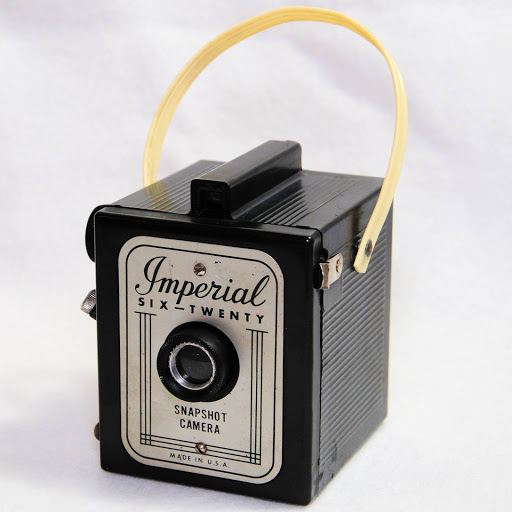The Chicago-based Herbert George Camera Co. (founded in 1945 by Herbert Weil and George Israel), which in 1961 became the Imperial Camera Co., manufactured a slew of simple plastic cameras. Since they were made in many colors, and some were "official" cameras for either the Boy Scouts or Girl Scouts, they have became collectibles in their own right. It's easy to dismiss these as mid-century plastic cameras, but imagine the millions of snapshots that probably resulted from them.
While many of them are better-made than the flimsy Diana, they are very simple snap-shot cameras, and may often give results that even a Diana would be envious of. The lenses are simple meniscus glass lenses, with a fixed aperture of about f/11 and shutter speed of about 1/30- 1/60 sec. Most of the cameras they produced took 127 or 620 film, with a few that took the Instamatic 126 cartridges in the latter half of the 1960s.
Although they are basic snapshot cameras, many did have some very nice styling and often incorporated a flash (bulbs only) in the body, or via a flash attachment. With so many other toy cameras available, they often get overlooked, but they are toy cameras in every sense of the word. My first example of an Imperial Mark XII looked to be in excellent condition. However, after shooting a roll of long-expired Tri-X, it appears that the lens is not aligned correctly. Every single image was slightly out-of-focus. I have since ordered another camera on eBay, and look forward to testing it.
 |
| Pretty, but oh so awful images! |
These cameras are simple. My latest acquisition is an Imperial Six-Twenty Snapshot Camera. Originally labeled as the Herco Six-Twenty about 1950, this camera must date from as far back as 1961, when Imperial became the brand. This camera is the most basic of plastic box cameras, measuring about 3.25, x 3.35 x 2.4 inches, weighing just over 6 ounces without film. I had seen results from the Six-Twenty online, and knew that it was capable of pretty acceptable results.
 |
| taped that yellow gel right over the lens. |
After I cleaned it up (amazing how grimy these cameras can be!), it was ready for a test. I loaded a roll of re-spooled 1997 expired Tmax 400, and taped on a yellow gel over the lens. I figured that it would be great if I got any sky in the photos. I took the camera for a quick trip to the Asheville River Arts District - a great place to test out a camera. I shot the roll and processed it it D-96. I am really thrilled with the results.
You don't have to spend a lot of money on this model, and price-wise, they are worth about $5-$10. If you don't mind respooling 120 onto 620 spools, there is a whole world of inexpensive cameras to play with. Look for the Imperial Debonair, Imperial Savoy, Imperial Mark XII, Imperial Six-Twenty, Imperial Deluxe Twin-Lens Reflex, and Herbert George Sabre 620. These will all give 12 6x6 cm images. Prices on eBay generally run from less than $10 to over $50, depending on the model and the color. If you don't mind respooling your film, these cameras will be great with 100 ISO films.
































